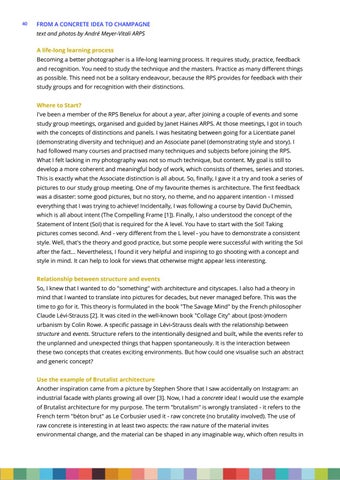40
FROM A CONCRETE IDEA TO CHAMPAGNE text and photos by André Meyer-Vitali ARPS A life-long learning process Becoming a better photographer is a life-long learning process. It requires study, practice, feedback and recognition. You need to study the technique and the masters. Practice as many different things as possible. This need not be a solitary endeavour, because the RPS provides for feedback with their study groups and for recognition with their distinctions. Where to Start? I've been a member of the RPS Benelux for about a year, after joining a couple of events and some study group meetings, organised and guided by Janet Haines ARPS. At those meetings, I got in touch with the concepts of distinctions and panels. I was hesitating between going for a Licentiate panel (demonstrating diversity and technique) and an Associate panel (demonstrating style and story). I had followed many courses and practised many techniques and subjects before joining the RPS. What I felt lacking in my photography was not so much technique, but content. My goal is still to develop a more coherent and meaningful body of work, which consists of themes, series and stories. This is exactly what the Associate distinction is all about. So, finally, I gave it a try and took a series of pictures to our study group meeting. One of my favourite themes is architecture. The first feedback was a disaster: some good pictures, but no story, no theme, and no apparent intention - I missed everything that I was trying to achieve! Incidentally, I was following a course by David DuChemin, which is all about intent (The Compelling Frame [1]). Finally, I also understood the concept of the Statement of Intent (SoI) that is required for the A level. You have to start with the SoI! Taking pictures comes second. And - very different from the L level - you have to demonstrate a consistent style. Well, that's the theory and good practice, but some people were successful with writing the SoI after the fact... Nevertheless, I found it very helpful and inspiring to go shooting with a concept and style in mind. It can help to look for views that otherwise might appear less interesting. Relationship between structure and events So, I knew that I wanted to do "something" with architecture and cityscapes. I also had a theory in mind that I wanted to translate into pictures for decades, but never managed before. This was the time to go for it. This theory is formulated in the book "The Savage Mind" by the French philosopher Claude Lévi-Strauss [2]. It was cited in the well-known book "Collage City" about (post-)modern urbanism by Colin Rowe. A specific passage in Lévi-Strauss deals with the relationship between structure and events. Structure refers to the intentionally designed and built, while the events refer to the unplanned and unexpected things that happen spontaneously. It is the interaction between these two concepts that creates exciting environments. But how could one visualise such an abstract and generic concept? Use the example of Brutalist architecture Another inspiration came from a picture by Stephen Shore that I saw accidentally on Instagram: an industrial facade with plants growing all over [3]. Now, I had a concrete idea! I would use the example of Brutalist architecture for my purpose. The term "brutalism" is wrongly translated - it refers to the French term "béton brut" as Le Corbusier used it - raw concrete (no brutality involved). The use of raw concrete is interesting in at least two aspects: the raw nature of the material invites environmental change, and the material can be shaped in any imaginable way, which often results in
